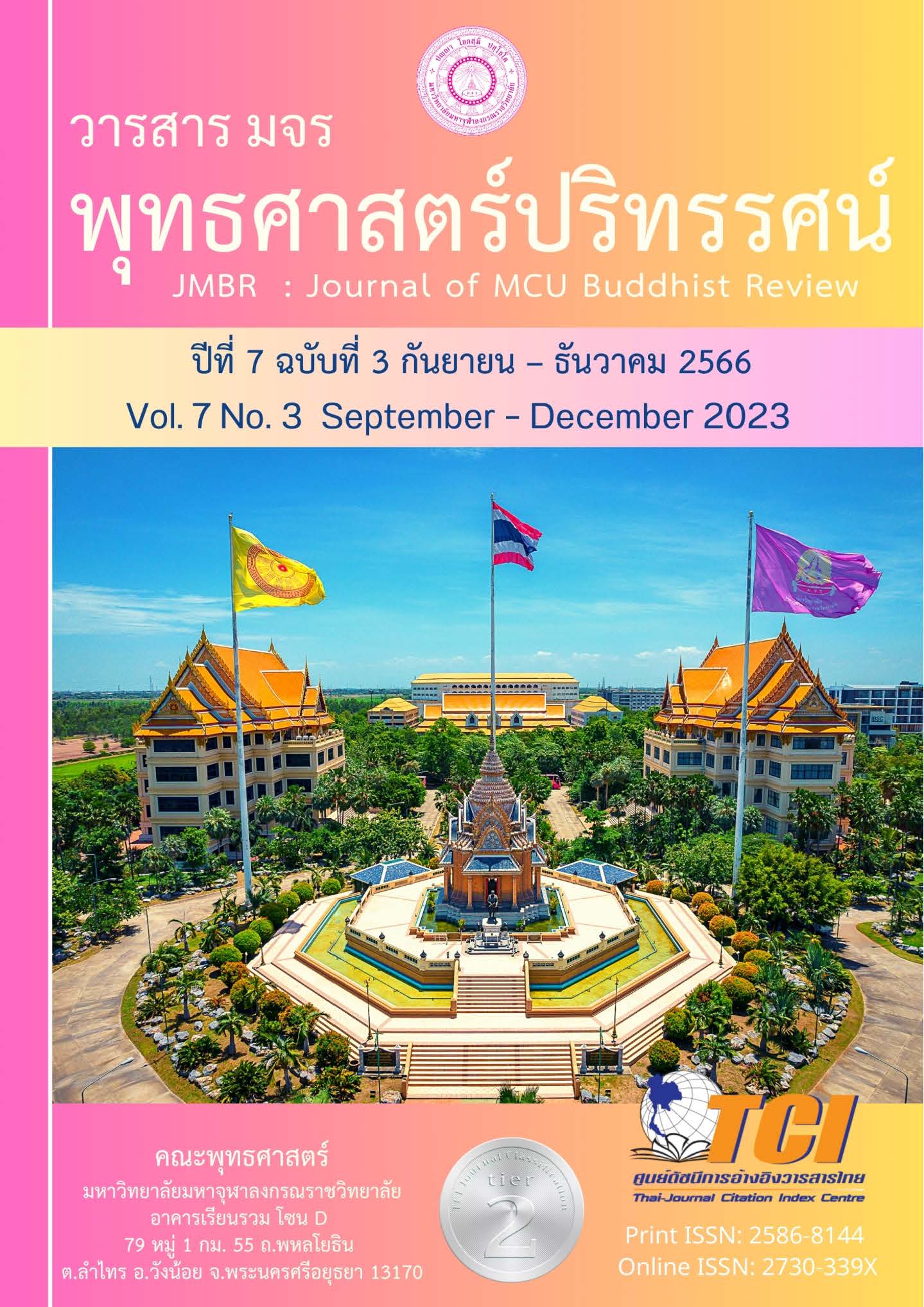การศึกษาวิเคราะห์เชิงเปรียบเทียบรูปแบบการเรียนรู้พหุวัฒนธรรมทางศาสนา เพื่อพัฒนาคุณภาพชีวิตระหว่างพุทธศาสนิกชนและคริสต์ศาสนิกชน ในตำบลบ้านกลาง อำเภอหล่มสัก จังหวัดเพชรบูรณ์
Main Article Content
บทคัดย่อ
บทความวิจัยนี้มีวัตถุประสงค์ 1) เพื่อศึกษารูปแบบการเรียนรู้พหุวัฒนธรรมทางศาสนาของพุทธศาสนิกชน 2) เพื่อศึกษารูปแบบการเรียนรู้พหุวัฒนธรรมทางศาสนาของคริสตศาสนิกชน 3) เพื่อเปรียบเทียบรูปแบบการเรียนรู้พหุวัฒนธรรมทางศาสนาของพุทธศาสนิกชน และคริสตศาสนิกชนในตำบลบ้านกลาง อำเภอหล่มสัก จังหวัดเพชรบูรณ์ ว่ามีความเหมือนและต่างกัน เป็นงานวิจัยแบบมีส่วนผสานวิธี ผ่านการสัมภาษณ์ศาสนิกของทั้งสองศาสนา กำหนดกลุ่มตัวอย่างเป็น 2 กลุ่ม ฝ่ายละ 10 คน รวม 20 คน เครื่องมือที่ใช้ในการเก็บข้อมูล 1) แบบสัมภาษณ์ และ 2) การสานเสวนา วิเคราะห์และนำเสนอเชิงพรรณนา
ผลการวิจัยพบว่า 1) รูปแบบการเรียนรู้พหุวัฒนธรรมทางศาสนาของพุทธศาสนิกชน ใช้โครงการหมู่บ้านศีล 5 มีวัดเป็นศูนย์การเรียนรู้เศรษฐกิจพอเพียงและสุขภาวะเชิงพุทธ นำหลักปฏิบัติตามปณิธาน 3 ของท่านพุทธทาสภิกขุ ได้แก่ 1) เรียนรู้ศาสนาของตนให้ถ่องแท้ 2) เรียนรู้ศาสนาของผู้อื่น 3) ร่วมกันดึงโลกออกจากวัตถุนิยม 2) การศึกษารูปแบบการเรียนรู้พหุวัฒนธรรมทางศาสนาของคริสตศาสนิกชน พบว่า การใช้หลักบัญญัติ 10 ประการ โดยมีโบสถ์และโรงเรียน เป็นสถานที่ให้ความรู้ทุกวันอาทิตย์ ช่วยให้มนุษย์ได้รับความรอดและมีอิสรภาพ พัฒนายกระดับจิตใจให้สูงขึ้น เป็นลักษณะคำสอนแห่งการแสดงออก มีความสดชื่นเป็นคำสอนแห่งชีวิตหรือ คำสอนอันมีชีวิตชีวา และแนวทางการปฏิบัติ ได้แก่ 1) แก่นของศาสนาเป็นหนึ่งเดียวกัน 2) ยึดหลักการของการเจรจาและการทำความเข้าใจ 3) สร้างศาสนิกของแต่ละศาสนาเพื่อทำความเข้าใจหลักธรรมของตน จึงทำให้เข้าใจผู้อื่น และอยู่ร่วมกันได้ โดยไม่มีความหวาดระแวงสงสัย 3) การเปรียบเทียบรูปแบบการเรียนรู้พหุวัฒนธรรมทางศาสนา เพื่อพัฒนาคุณภาพชีวิตระหว่างพุทธศาสนิกชนและคริสตศาสนิกในตำบลบ้านกลาง อำเภอหล่มสัก จังหวัดเพชรบูรณ์ พบว่าการเรียนรู้ไม่มีความแตกต่างเพราะผู้นำของทั้งสองศาสนา เน้นสร้างเหตุแห่งความสุข คือ สงบ สันติ เบิกบานใจ อยู่ร่วมกันฉันท์พี่น้อง มีความแตกต่างกันเพียงความศรัทธาในศาสนาของตนไม่ก้าวล่วงวิถีปฏิบัติทางศาสนาของบุคคลอื่น
Article Details

อนุญาตภายใต้เงื่อนไข Creative Commons Attribution-NonCommercial-NoDerivatives 4.0 International License.
- บทความที่ได้รับการตีพิมพ์เป็นลิขสิทธิ์ของวารสาร มจร พุทธศาสตร์ปริทรรศน์
- ข้อความใดๆ ที่ปรากฎในบทความที่ได้รับการตีพิมพ์ในวารสาร ถือเป็นความรับผิดชอบของผู้เขียนบทความ และข้อคิดเห็นนั้นไม่ถือว่าเป็นทัศนะและความรับผิดชอบของกองบรรณาธิการวารสาร มจร พุทธศาสตร์ปริทรรศน์
เอกสารอ้างอิง
กีรติ บุญเจือ. (2529). หลักความเชื่อของชาวคริสต์คาทอลิก. กรุงเทพฯ: ไทยวัฒนาพานิช.
คณะกรรมการคาทอลิกเพื่อคริสตธรรม แผนกพระคัมภีร์. (2514). พระคัมภีร์คาทอลิก ฉบับสมบูรณ์ ภาคพันธ-สัญญาเดิม และภาคพันธสัญญาใหม่. กรุงเทพฯ: คณะกรรมการคาทอลิกเพื่อคริสตธรรม แผนกพระคัมภีร์.
จำนงค์ ทองประเสริฐ. (2548). ศาสนาเปรียบเทียบระหว่างพระพุทธศาสนากับคริสต์ศาสนา. กรุงเทพฯ: หจก. สำนักพิมพ์และสายส่งดวงแก้ว.
เดือน คำดี. (2529). การเผยแพร่ศาสนาคริสต์ในประเทศไทย. กรุงเทพฯ: สำนักพิมพ์ โอเดียน.
บาทหลวงยอแซฟ วุฒิเลิศ แห่ล้อม. (2012). หลักธรรมคำสอนคาทอลิก. จังหวัดเชียงใหม่: สำนักมิซังคาทอลิก.
พุทธทาสภิกขุ. (2537). แก่นพุทธศาสตร์. กรุงเทพฯ: โรงพิมพ์สามลดา.
พุทธทาสภิกขุ. (2549). ปณิธาน 3 ประการ. กรุงเทพฯ: โรงพิมพ์ธรรมสภา.
พระพรหมคุณาภรณ์ (ป.อ. ปยุตฺโต). (2551). สุขภาวะองค์รวมแนวพุทธ. กรุงเทพฯ: บริษัท สหมิตรพริ้นติ้งแอนพับลิสซิ่ง จำกัด.
พระพรหมบัณฑิต (ประยูร ธมฺมจิตฺโต). (2562). ความสุขที่ยั่งยืน. กรุงเทพฯ: หจก. สามลดา.
มหาวิทยาลัยมหาจุฬาลงกรณราชวิทยาลัย. (2539). พระไตรปิฎกภาษาไทย ฉบับมหาจุฬาลงกรณราชวิทยาลัย. กรุงเทพฯ: มหาจุฬาลงกรณราชวิทยาลัย.
สมเด็จพระญาณสังวร สมเด็จพระสังฆราช สกลมหาสังฆปริณายก. (2558). ชีวิตลิขิตได้. กรุงเทพฯ: บริษัทแสงสว่างเวิลด์เพรส จำกัด.
สมเด็จพระญาณสังวร สมเด็จพระสังฆราช สกลมหาสังฆปริณายก. (2550). คิดให้รู้จักพอ และการทำดีต้องไม่มีพอ. กรุงเทพฯ: โรงพิมพ์นพรัตน์.


